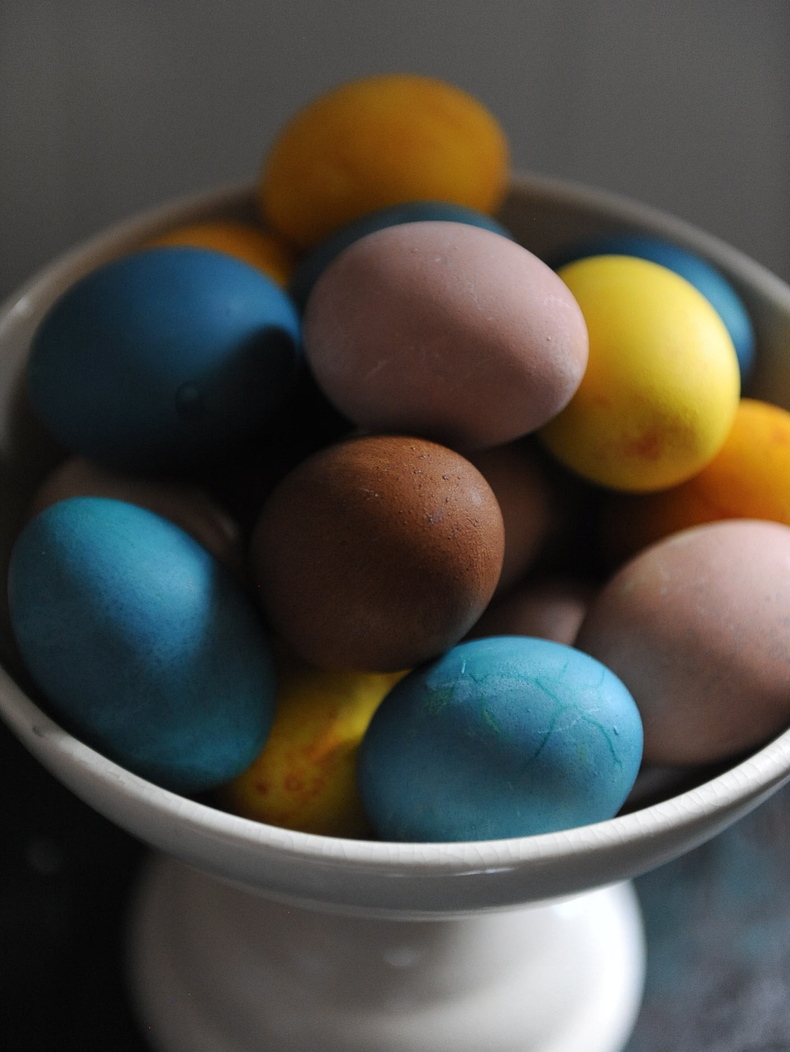3.27.10 Eastover Celebration

Raised between 2 religions and 2 cultures, I have retained some of both and all of neither. Dyeing Easter eggs is a tradition I hope never to relinquish. This year I will be heading to Turks & Caicos for a beachy holiday that will most likely obviate both Passover and Easter, but I may still find time to dye some eggs when I return home. And maybe even cook the meal we've begun calling Eastover, a funny hybrid that might start with a ham and finish with macaroons. Would it surprise you to know that for dyeing eggs I no longer use anything artificial? Yep, I'm going to try to get you to make your own dyes from natural ingredients! We have the ODG (Original Domestic Goddess) Martha Stewart to thank for these great instructions. I followed them last year and look at the gorgeous bowl of eggs I got out of it. I still have a big jar of beet juice in the fridge. I thought I was going to dye some piece of clothing but I never got around to it. Just like those geranium sachets I was going to make for Christmas presents. Maybe next year. Inshallah.
So go on and gather your vegetable ingredients, a few dozen eggs, and whatever willing extra hands you can rustle up (gay men and little girls are best). Don't even tell yourself you're going to whip up a bunch of egg salad with these afterwards (they'll be overcooked). Make the investment in a beautiful centerpiece for your Easter lunch and leave it at that. I'll be thinking of you in all your ambitious industry as I'm lying prone on the sand.
WHAT YOU’LL NEED
Natural dyeing agents (red cabbage, turmeric, onion skins, beets, coffee)
3-quart pot
White vinegar
Strainer
Bowls
Eggs
Large metal spoon
Paper towels
Drying rack
DYES
Choose your dyeing agent and place it in the pot using the amount listed below. Add 1 quart water and 2 tablespoons white vinegar to pot; if more water is necessary to cover ingredients, proportionally increase the amount of vinegar. Bring to a boil, then lower heat and simmer for 30 minutes. Strain dye into a bowl.
Red-cabbage dye: 4 cups chopped cabbage
Turmeric dye: 3 tablespoons turmeric
Onion-skin dye: 4 cups onion skins (skins of about 12 onions)
Beet dye: 4 cups chopped beets
Coffee dye: 1 quart strong black coffee (substitute for water water)
COLD-DIPPING METHOD
With this method, the eggs and the ingredients for the dye are boiled separately. Using a metal spoon, lower cooled hard-boiled eggs into a bowl of cooled dye, and let them soak for as little as 5 seconds or as long as overnight, depending on the depth of color you want. Gingerly remove eggs with spoon, pat dry with paper towels, and let dry on a wire rack. The cold-dipping method produces subtle, translucent shades, but can result in uneven coloring unless the eggs are rotated vigilantly while in the dye.
BOILED METHOD
This method involves boiling the eggs with the dye; the heat allows the dye to saturate the shells, resulting in intense, more uniform color. Set raw eggs in a pot of strained dye; bring to a boil for the amount of time specified in the color glossary below. Remove and dry eggs as with the cold-dipping method.
COLOR GLOSSARY
Natural dyes can sometimes produce unexpected results, so don't be surprised if, for example, your red-cabbage dye yields blue eggs. Use the following guide to help you achieve the colors you desire.
Deep Gold: Boil eggs in turmeric solution, 30 minutes.
Pale Yellow: Soak eggs in room-temperature turmeric solution, 30 minutes.
Sienna: Boil eggs in onion-skin solution, 30 minutes.
Orange: Soak eggs in room-temperature onion-skin solution, 30 minutes.
Dark Brown: Boil eggs in black coffee, 30 minutes.
Light Brown: Soak eggs in room-temperature black coffee, 30 minutes.
Fuchsia: Boil eggs in beet solution, 30 minutes.
Light Pink: Soak eggs in room-temperature beet solution, 30 minutes.
Light Blue: Soak eggs in room-temperature cabbage solution, 30 minutes.
Royal Blue: Soak eggs in room-temperature cabbage solution overnight.
Lavender: Soak eggs in room-temperature beet solution, 30 minutes. Follow with room-temperature cabbage solution, 30 seconds.
Chartreuse: Soak eggs in room-temperature turmeric solution, 30 minutes. Follow with room-temperature cabbage solution, 5 seconds.
Salmon: Soak eggs in room-temperature turmeric solution, 30 minutes. Follow with room-temperature onion-skin solution, 30 minutes.






1 Comment